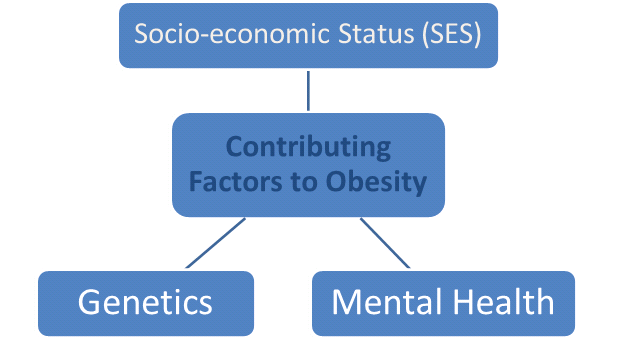Physiotherapy communication approaches in management of obesity and overweight: Difference between revisions
Lucy O'Brien (talk | contribs) |
Lucy O'Brien (talk | contribs) |
||
| Line 28: | Line 28: | ||
== Contributing Factors to Obesity == | == Contributing Factors to Obesity == | ||
[[File: | [[File:Contributing factors.png]] | ||
''' Socio-economic Status (SES) ''' | ''' Socio-economic Status (SES) ''' | ||
Revision as of 12:45, 27 October 2015
Original Editor - Your name will be added here if you created the original content for this page.
Top Contributors - Lucy O'Brien, Eirik Gulbrandsen, Giulia, Ong Kai Ning, Kim Jackson, Lucinda hampton, Rebecca Fairbairn, 127.0.0.1, Admin, George Prudden, WikiSysop, Aminat Abolade and Jane Hislop
Introduction[edit | edit source]
https://www.onlineexambuilder.com/obesity-quiz-how-much-do-you-know/exam-42680
Definition of Obesity[edit | edit source]
Obesity is where an individual is carrying excess body fat which can increase the chances of developing secondary diseases. Obesity can be measured by Body Mass Index (BMI) as shown:
BMI 25-29.9 – overweight
BMI 30-39.9 – obese
BMI 40+ - severely obese
However, to measure obesity more reliably waist circumference can also be measured where females as classed as obese is measuring over 80cm and males over 94cm. Fat percentages can also be calculated to give a truer measurement of obesity (NOO 2011; NHS 2014a).
Implications of Obesity[edit | edit source]
There are many implications of obesity worldwide. Obesity increased the risk of many long-term health conditions such as type 2 diabetes, heart disease, arthritis, hypertension, cancer, stroke, liver problems, respiratory problems, sleep issues, mental health disorders and overall may cause a reduced quality of life (Keenan et al. 2011).
With the rising obesity and reduced staff, funding and resources within the NHS the demand on the health service is huge. This could ultimately lead to reduced quantity and quality of care. Obesity also contributes to wider financial problems such as more benefit outgoings and loss of output within the economy (Public Health England 2015). In addition, obese patients have an increased recovery time which leads to and increased length of hospital stay which further adds more pressure on the health service due the increased demand for hospital beds. Therefore, there is an increased demand for bariatric equipment which with the reduced funding and resources within the NHS currently results in difficulty (CSP 2015b).
Contributing Factors to Obesity[edit | edit source]
Socio-economic Status (SES)
There are many factors that influence obesity. One large area that influences obesity is socio-economic factors. There are many areas within this topic that effect people in various different ways such as:
• Occupation
• Smoking
• Cost of food
• Deprived living conditions
• Technology
• Income
• Education
• Sedentary lifestyles
(Baum and Chou 2011).
Socioeconomic status refers to a person’s position compared to other people’s personalities, this has contributed to putting people into certain categories allowing evaluation of discrimination between these public categories (National Obesity Observatory 2010).
The accessibilities of food shops and the number of services that allow physical activity influence the levels of obesity. Akil and Ahmad in 2011 show the highest obesity levels are mostly found within the people who:
• Earn the least
• Are not taught to a high level about obesity and health aspects
• Are not educated to a high level in general.
They also illustrate that unhealthier foods are less expensive and more instantly available within deprived areas. Overall, deprived areas to live in are a huge factor contributing to obesity especially in woman.
The MRC National Survey of Health and Development showed that BMI was directly connected with educational success in both sexes. This most increased obesity levels were found in the people with the least academic achievements. 11% of men with O-grade level achievements had a BMI above 30, whereas, only 5% of men’s BMI were over 30 when they were at degree level of attainment. The same result showed within females as well correspondingly 15% and 4% (Fehily 1999).
The Role of Physiotherapy[edit | edit source]
How Can Communication Be Used to Facilitate Behaviour Change?[edit | edit source]
Recent Related Research (from Pubmed)[edit | edit source]
Extension:RSS -- Error: Not a valid URL: Feed goes here!!|charset=UTF-8|short|max=10
References[edit | edit source]
References will automatically be added here, see adding references tutorial.







